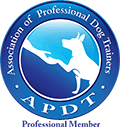Archive CF :: Building Trust
Trust is a much overlooked quality of our relationships with our dogs. Just as we seek to build trust with our dogs, then we will unwittingly undermine it. While using some tricky maneuvers may be necessary in a pinch, relying on them in the daily routine will subtlety erode the fabric of our relationships with our canine companions. Here are some pitfalls to keep an eye out for...
Employing Deception
It was this technique that my clients were using to depart from their home that first prompted me to consider trust in human/canine relationships. Because their dog Snoop (name changed to protect anonymity) would charge out the door every time they would try to leave home, they had taken to lobbing a dog biscuit far across the room as they beat a hasty departure from the apartment. Rather than training Snoop to behave in a way that they'd prefer, they exploited a deception. The result was that Snoop, soon wise to them, was becoming more aroused around the door and with their leaving.
By training Snoop to go to place, teaching him a "wait" while a tasty Kong was placed in front of him, and then releasing him to the Kong as they departed, Snoop was practicing relaxed behavior with doorway activity, while also learning to enjoy their absence, and he was mastering the art of impulse control.
Punishing Fear
Fear in dogs is very often interpreted as aggression by their humans. A leashed dog will express her fear of other dogs by making an aggressive display of lunging and barking that is anything but the bravado it looks like to us. Punishing a fear-motivated display, by giving a leash correction, for example, only serves to make the dog more fearful, as now she has reason to fear her owner's reaction as well as the perceived danger of the other dog. And, from her perspective, the human upon whom she relies most in times of danger is intensifying the situation rather than assuaging it.
When treating fear, use a combination of desensitizing (DS: reframing the stimulus in a way that no longer elicits fear) and counter-conditioning (CC: changing the emotional response) your dog to the fearful stimulus. Check out my article Harnessing the Power of Pavlov for help in treating fear.
Ignoring the Message
Dogs have few ways of expressing themselves. A dog is begging the listener to hear his plight when he hides under furniture in an attempt to evade being caught or rolls over on his back, in a position of passive submission called a "tap-out", to avoid certain handling. When we insist on our course of action, we not only communicate to him that we're not respecting his message, but we also increase the probability that he might bite.
Just as with fear, when treating discomfort about certain handling, DS/CC is a powerful one-two punch. The goal is to change your dog's emotional mind about such handling so that he comes to actually enjoy it!
Punishing Warning
Some dogs lift a lip or growl when you near them while they're in possession of a resource. This is a dog's natural way of communicating his discomfort with you near his resources. Do not punish him for his warning. By reprimanding him for growling his discomfort, you have said that you have no respect for his expression and it erodes his trust for you near his things. In fact, you may force him to escalate his expression -- next time, he may have to bite!
Instead, step back and consider ways in which you can make him more comfortable with your presence. For instance, when working around his food bowl, make approaches to your dog's bowl, stopping at a safe distance where he shows no discomfort or guarding behavior, and then toss something of higher value than what he's eating. Withdraw and approach over and over again, each time stopping at a distance where he does not feel threatened or uncomfortable. Over time, you will notice him lifting his head in anticipation of you approach. This means he is now looking forward to your approaches with happy anticipation!
The Snatch and Grab
Of course there are times when we must snatch things out of our dogs' mouths. But repeatedly and unceremoniously taking things away from your dog that she finds valuable without offering reward in return will soon erode her trust in you to share fairly.
By teaching your dog to drop things on command, you will establish her trust that you are a good sharer. If she's got hold of something, say "Drop it!" and then hold a treat to her nose. When she drops the toy, give her the treat and take the toy. Then offer her the toy back. The key is to do so many repetitions with articles that you immediately return to her that she comes to think "drop it" is a win-win situation: She gets a treat for doing it and she gets the toy back. Why wouldn't she trust you the next time you ask her to relinquish her mouthful?!
Forced Atonement
Most upsetting is the one so often employed in popular dog training media these days -- putting a dog on his side in a prone position for what we deem a misbehavior. Beyond its being an extreme example of punishing fear (see above), this is a very dangerous technique. For the human, there is a very high risk of getting bitten. For the dog, should there be an actual danger imminent (like dogs who may pounce upon him at the dog run), he is at terrible risk. But, finally and most alarmingly, from the dog's perspective, the message is that his human will throw him to the lions for such displays of emotional content.
As with the others, change your dog's emotional mind about the object of his fear through DS/CC. Teach him to trust that you will keep him from harm. If you don't know how to resolve things on your own, seek out the help of a certified canine behavior specialist.
Do you know what your dog is trying to tell you? Moreover, do you know what you are truly telling your dog? Make sure that your actions truly foster the love, respect, and trust that you want in your relationship with your canine companion.




